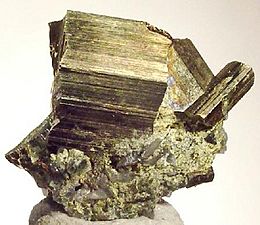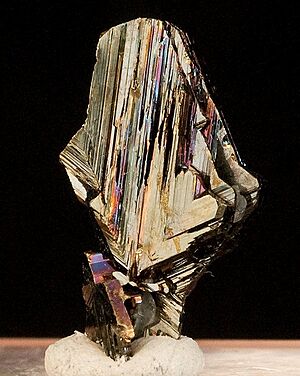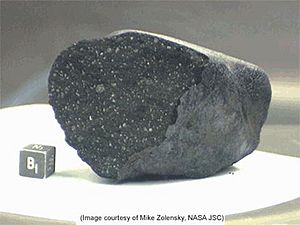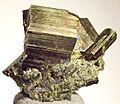Cubanite facts for kids
Quick facts for kids Cubanite |
|
|---|---|

Striated, cyclically-twinned cubanite crystals from the Chibougamau mines of Quebec. (size: 1.5 x 1.3 x 1.0 cm)
|
|
| General | |
| Category | Sulfide mineral |
| Formula (repeating unit) |
CuFe2S3 |
| Strunz classification | 2.CB.55a |
| Crystal symmetry | Pcmn |
| Unit cell | a = 6.467(1) Å, b = 11.117(1) Å, c = 6.231(2) Å; Z = 4 |
| Identification | |
| Color | Bronze to brass-yellow |
| Crystal habit | Crystals elongated to thick tabular, striated also massive |
| Crystal system | Orthorhombic |
| Twinning | Common with twin plane {110} in pairs, also as fourlings and pseudohexagonal sixlings |
| Cleavage | Parting on {110} and {130} |
| Fracture | Conchoidal |
| Mohs scale hardness | 3.5-4 |
| Luster | Metallic |
| Streak | Black |
| Diaphaneity | Opaque |
| Specific gravity | 4.0-4.2 |
| Optical properties | Distinctly anisotropic on polished surface |
| Other characteristics | Strongly magnetic |
Cubanite is a special kind of mineral that contains copper, iron, and sulfur. Its chemical formula is CuFe2S3. When you find cubanite, it usually looks like a shiny bronze or brass-yellow color.
This mineral is not super hard. On the Mohs hardness scale, it scores between 3.5 and 4. This means you could scratch it with a steel knife. Cubanite forms in an orthorhombic crystal system, which means its crystals have a specific box-like shape. It's related to another common mineral called chalcopyrite, but cubanite is much rarer.
You can often find cubanite in hot, watery places deep underground called hydrothermal deposits. It often grows alongside other minerals like pyrrhotite and pentlandite. Cubanite forms when chalcopyrite cools down below 200 to 210 degrees Celsius. If it gets hotter than 210 degrees Celsius, cubanite changes into a different form called isocubanite. Once it becomes isocubanite, it won't turn back into cubanite even if it cools down. When it changes to isocubanite, it also loses its strong magnetic power.
Contents
What's in a Name?

The name Cubanite comes from the Spanish word Cubano, which means Cuban. The ending -ite is often added to mineral names. This mineral was first officially described in 1843. It was found in a place called the Mayarí-Baracoa Belt in the Holguín Province of Cuba. Sometimes, you might even see it called barracanite in old books.
How Cubanite Forms
Cubanite is a minor mineral that forms when other magmatic ores change over time. This happens because of hot water moving through the rocks, a process called hydrothermal alteration. For cubanite to form from chalcopyrite, the original minerals need to lose some copper and gain more iron. This change makes the crystal structure shift from a square shape (tetragonal) to a more rectangular shape (orthorhombic).
As mentioned before, if the temperature goes above 210 degrees Celsius, cubanite changes into isocubanite. This new form has a different crystal structure and won't change back to cubanite when it cools.
Cubanite from Space!

Even though cubanite usually forms deep inside Earth, scientists have found it in places far away from our planet! It has been discovered in carbonaceous chondrite meteorites, which are rocky pieces that fall to Earth from space. It was also found in dust grain samples collected by NASA’s Stardust spacecraft.
Even more exciting, a tiny piece of cubanite was found on the Itokawa asteroid. This discovery was made by the Hayabusa spacecraft. This was the first time cubanite was found on an asteroid that wasn't a "C-type" asteroid. However, scientists think this cubanite might have come from somewhere else and just landed on Itokawa.
Making Cubanite in the Lab
Scientists can even make cubanite in a lab! This helps them understand how cubanite forms in space, especially in those meteorites. They use a special method that's like the hydrothermal process found in nature. By heating different mixtures of copper, iron, and sulfur to temperatures between 150-200 degrees Celsius, they can create cubanite. These experiments help us learn more about the minerals found in space rocks.
Images for kids
See also
 In Spanish: Cubanita para niños
In Spanish: Cubanita para niños




